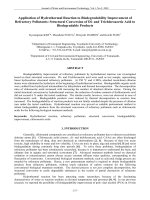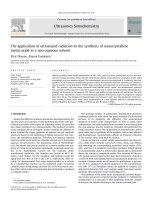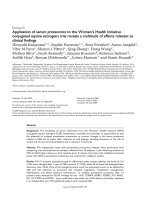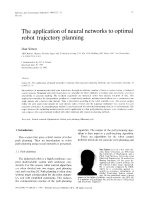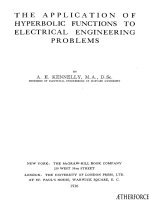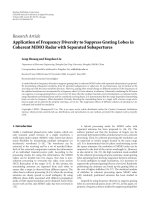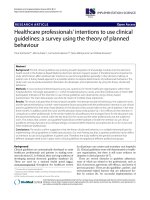An application of an extended theory of planned behaviour to understand drivers compliance with the school zones speed limit in australia and malaysia
Bạn đang xem bản rút gọn của tài liệu. Xem và tải ngay bản đầy đủ của tài liệu tại đây (4.63 MB, 310 trang )
An application of an extended Theory of Planned
Behaviour to understand drivers' compliance
with the school zones speed limit in
Australia and Malaysia
Suhaila Abdul Hanan
BBA Transport, MSc Transportation Planning
Principal Supervisor: Dr Mark King, BSc (Hons), MBA, PhD
Associate Supervisor: Dr Ioni Lewis, BSc(Psych), BPsych(Hons), PhD
Submitted in fulfilment of the requirements for the degree of
Doctor of Philosophy
Centre for Accident Research and Road Safety- Queensland
Faculty of Health
Queensland University of Technology
2014
i
Keywords
Australia, Compliance behaviour, Habit, Malaysia, Mindfulness, Speeding, Theory
of Planned Behaviour.
ii
iii
Abstract
Violation of the speed limit contributes to the incidence and severity of road crashes.
In school zones in Australia and Malaysia, although fatality numbers are low and
many countermeasures have been implemented (e.g., speed limit signage, school
zones road marking and traffic calming), evidence shows that both countries have a
problem with drivers who are not complying with the school zones speed limit
(SZSL). Such evidence raises questions of why drivers are not complying with the
SZSL, given the highly vulnerable road users, children, who are likely to be in the
area. Presently, there has been little investigation of driver behaviour in relation to
school zones and of those studies available, none have investigated the psychosocial
factors which influence drivers’ compliance. The current research attempted to
address this gap, employing an extended Theory of Planned Behaviour (TPB) to
examine the contribution of psychosocial and situational factors to drivers’
compliance with the SZSL in both Australia and Malaysia. In addition to the
standard TPB variables (i.e., attitude, subjective norm and perceived behavioural
control, or PBC), the research included two additional variables of habit and
mindfulness. An extended TPB model was developed that hypothesised that habit
and mindfulness could each contribute directly to intention, or directly to behaviour,
or moderate the intention-behaviour relationship. Further, the effect of the situational
factors, the presence and absence of both school children in the school zones and
other drivers speeding in school zones was investigated.
Qualitative and quantitative methods were utilised in four studies conducted in
Queensland, Australia and Kedah, Malaysia. Each of the studies was informed by,
and built upon, the preceding study/ies. Initially, this research program intended to
focus upon speeding in school zones. However, it was decided after the first
qualitative study in Australia (Study 1a) that it would likely be more relevant and
provide greater insight if the focus was changed from speeding to investigating
drivers’ compliance with the school zones speed limit. Thus, Study 1a was designed
to elicit beliefs relating to speeding in school zones in Australia, and involved 17
participants across four focus group discussions, each of about one hour’s duration. It
was found that speeding in school zones was considered a largely undesirable and
dangerous behaviour. As the discussion continued, it appeared that participants did
iv
not feel comfortable admitting that they had sped in school zones, and preferred to
talk in terms of compliance. Considering these findings carefully and
comprehensively, the decision was made early in the research program to focus on
drivers’ compliance. In relation to the key findings, situational factors, in particular
the absence of school children, emerged as important contributors to control beliefs,
demonstrating the need to consider the role and influence of other road users. The
findings also suggested that speeding in school zones is more likely to be
unintentional and largely because a driver was engaging in the behaviour mindlessly.
Study 1b in Malaysia was an elicitation study focusing on compliance with the
SZSL. It involved 13 participants across three focus group discussions. The study
revealed that compliance with the SZSL was a desirable and acceptable behaviour
and that significant others would approve of one engaging in such a behaviour. This
study also found that the presence and absence of school children and other drivers
speeding in school zones were situational factors which may influence compliance.
In particular, the visible presence of school children was a factor which may increase
drivers’ awareness that they are approaching or driving through a school zone, thus
making it easier for them to comply with the SZSL. On the other hand, the presence
of other drivers speeding in school zones may increase pressure on individual
drivers, and thus increase the likelihood that an individual driver may increase their
speed.
For the main study (i.e., Study 2a), Australian drivers (N=200) participated in
surveys at two time points: Time 1 and at Time 2 (N=118) four weeks later. The
results of a hierarchical regression showed that the overall model based on the
extended TPB framework explained a significant 39% of the variance in intention to
comply with the SZSL. Attitude, PBC, and mindfulness emerged as significant
predictors while subjective norm and habit did not make any significant contribution
to the model. In relation to self-reported actual compliance with the SZSL (i.e.,
measured at Time 2), in Australia, logistic regression results indicated that drivers
who intended to comply with the SZSL were 35 times more likely to actually comply
than non-intenders. In this analysis, only intention made a statistically significant
contribution in the overall model. In addition, mindfulness and habit were also tested
as possible moderators in the intention–behaviour relationship. The analysis was
v
conducted separately for each variable. The result of the moderation analysis
revealed that neither mindfulness nor habit were significant moderators between
intention and behaviour.
Overall, the results of the Australian study provided partial support for the efficacy
of the TPB in predicting intentions and actual compliance with the SZSL among
drivers in Queensland, Australia. Attitude and PBC accounted for significant
variance in intention to comply with the SZSL while subjective norm did not make
any significant contribution. The latter finding is not surprising given that previous
studies have suggested that subjective norm may be the weakest of the predictors
within the TPB. Other normative influences therefore may need to be considered.
Relating to the additional constructs of mindfulness and habit, only mindfulness was
found to be a significant predictor of intention and not behaviour. These findings
suggest that greater mindfulness does not increase the likelihood that intention is
translated into behaviour.
In Malaysia (i.e., Study 2b), 210 drivers completed the online survey at Time 1 and
24 drivers continued to complete the follow-up survey at Time 2 four weeks later.
Unfortunately, the number of responses at Time 2 was too small to enable an analysis
to predict behaviour. Therefore, in Study 2b intention was analysed as the key
outcome variable rather than behaviour. The overall model based on the extended
TPB framework explained a significant 51% of the variance in intention to comply
with the SZSL. Study 2b indicated that attitude, subjective norm, PBC, and habit
were all significant predictors of intention. Mindfulness, however, did not make any
significant contribution. The findings of this study provided support for the
application of the TPB to understand drivers’ intended compliance with the SZSL in
Malaysia. Attitude, subjective norm, and PBC were all significant predictors of
intention to comply with the SZSL. Interestingly, while mindfulness emerged as
significant predictor of intention in Study 2a (in Australia), in Malaysia, habit was a
significant predictor of intention, but mindfulness was not. It is speculated that the
discrepancy findings may be due to differences in countermeasures implemented in
the two countries. In Malaysia, countermeasures such as alert bars or speed humps
are permanently implemented, whereas in Australia they usually operate only during
the hours before and after school. The use of such permanent countermeasures in
vi
Malaysia may make a driver become familiar with driving through school zones and
develop a habit of complying.
In addition to the individual factors, Study 2a and Study 2b also identified beliefs
that influenced individuals’ intention to comply with the SZSL. The beliefs
examined were informed by the findings of Study 1. Von Haeften’s (2001)
guidelines were used in order to identify the critical beliefs underpinning drivers’
intention to comply with the SZSL. The findings of these analyses revealed that
beliefs regarding ensuring the safety of school children (behavioural beliefs) and the
presence of a crossing supervisor in school zones (control beliefs) were important
influences on drivers’ intention to comply with the SZSL in Australia and Malaysia.
In addition, for Malaysian drivers, control beliefs relating to the presence of
motorcyclists and school children in the school zones, knowledge about it being
school day, and the existence of school zones signage were also considered as
important factors which may increase drivers’ intention to comply. Overall, when
considering Study 2a and Study 2b findings, the findings suggest that Malaysian
drivers may require more visible and noticeable school zones to facilitate their
compliance with the SZSL than Australian drivers, to enhance existing habits of
compliance fostered by the permanent installation of countermeasures mentioned
above.
Study 2 also was designed to investigate differences in drivers’ reported intentions,
in a 2 x 2 between groups design in which the presence and absence of school
children and other drivers speeding or when driving alone in school zones were
manipulated via a series of scenarios. The results showed that, in Australia (Study
2a), there was a significant main effect of the presence of other drivers speeding in
school zones such that individuals reported lower intentions to comply when driving
in the presence of other drivers speeding. For Malaysian drivers (Study 2b), there
was a significant main effect of presence of school children in school zones which
indicated that those who drove in the presence of school children had higher
intentions to comply. No other effects were significant in either the Australian or
Malaysian analyses.
vii
The current research has important theoretical, methodological, and practical
implications. The research provides support for the application of the TPB to
understand drivers’ compliance with the speed limit across cultures; namely,
Australia and Malaysia. Further, the current research also provides qualified support
for the inclusion of habit and mindfulness to aid the understanding of driver
behaviour. In particular, despite the differences in Australian and Malaysian findings,
this research highlighted the importance of habit and mindfulness in understanding
drivers’ behaviour compliance with the SZSL, and their role in other driver
behaviours is worth following up. In particular some of the findings related to
mindfulness appear to be contradictory, and it is likely that the conceptualisation of
mindfulness as it applies to driving needs further articulation and clarification.
With regard to methodological implications, although an established mindfulness
scale was used (i.e., Mindfulness Awareness Attention Scale (MAAS)), the findings
suggest more research is needed. This is because several of the mindfulness items
imply a degree of self awareness such that a person might rate low on mindfulness
because they are aware of their own shortcomings in particular situations, whereas a
person who is unaware may self-report higher scores on the scale and be apparently
more mindful. They may incorrectly assume that they will intend to comply with the
speed limit but not do so. Future research is needed in this area, in conjunction with
the theoretical articulation of mindfulness in driving. This research provides evidence
that habit (as measured by the Self Report Habit Index (SRHI)) is different from past
behaviour frequency, which is usually used to reflect habit (Verplanken & Melkevik,
2008). The SRHI assesses a number of items that characterise the automatic nature of
habits (Danner, et al., 2008). As such, the current research provides support for the
reliability and validity of SRHI as a scale that could be used in future research,
specifically, driver behaviour-related research.
In terms of practical implications, road safety interventions, such as advertising or
public education strategies, may be most successful if they focus on individuals’
attitude, subjective norm and PBC. For example, strategies could benefit from
reinforcing the positive consequences associated with complying with the SZSL or
emphasise the negative consequences of speeding in this area, heightening the
perception that a range of referents would approve of this behaviour, and
viii
emphasizing that compliance behaviour could be performed easily. In addition, in
order to reduce unintentional speeding and increase awareness and develop mindful
drivers in school zones, the current research also suggests the need to increase the
visibility of school zones with the use of more noticeable traffic control devices, such
as flashing lights, speed humps and pavement treatments to increase the visibility of
school zones. Doing so, may consequently heighten drivers’ awareness that they are
approaching a school zone. Such strategies informed by this research may ultimately
help reduce the risk of crashes involving vulnerable road users.
ix
Table of Contents
Keywords .................................................................................................................................................i
Abstract ................................................................................................................................................. iii
Table of Contents ...................................................................................................................................ix
List of Figures ..................................................................................................................................... xiii
List of Tables ........................................................................................................................................ xv
List of Abbreviations.......................................................................................................................... xvii
Statement of Original Authorship ........................................................................................................xix
Acknowledgements ..............................................................................................................................xxi
CHAPTER 1: RATIONALE FOR THE RESEARCH ..................................................................... 1
1.1
Chapter introduction .................................................................................................................... 1
1.2
Rationale for the research ............................................................................................................ 1
1.3
The need for theoretically based research .................................................................................... 3
1.3.1 Additional variables: Habit and mindfulness .................................................................... 5
1.4
Defining speeding and compliance with the SZSL ...................................................................... 8
1.5
Research aims and research questions ......................................................................................... 9
1.6
Scope of the research program ................................................................................................... 10
1.7
Outline of the dissertation .......................................................................................................... 11
1.8
Chapter summary ....................................................................................................................... 12
CHAPTER 2: CHILD PEDESTRIANS AND SCHOOL ZONES ................................................. 13
2.0
Chapter introduction .................................................................................................................. 13
2.1
Road safety and child pedestrians .............................................................................................. 13
2.2
Factors associated with child pedestrian crashes ....................................................................... 14
2.2.1 Child characteristics and behaviour ................................................................................ 14
2.2.2 Road environment factors ............................................................................................... 16
2.2.3 Driver behaviour ............................................................................................................. 17
2.2.3.1 School zones, countermeasures, and driver behaviour................................................... 19
2.3
Rationale for the Australian and Malaysian studies ................................................................... 21
2.3.1 Australia ......................................................................................................................... 21
2.3.2 Countermeasures in school zones ................................................................................... 23
2.3.3 Malaysia ......................................................................................................................... 25
2.3.4 Differences between school zones in Australia and Malaysia ........................................ 30
2.4
Cross cultural research in driver behaviour ............................................................................... 31
2.5
Conclusions................................................................................................................................ 33
2.6
Chapter summary ....................................................................................................................... 34
CHAPTER 3: THEORETICAL APPROACH TO UNDERSTAND DRIVER BEHAVIOUR ... 35
3.1
Chapter introduction .................................................................................................................. 35
3.2
Health belief model (HBM) ....................................................................................................... 35
3.3
Theory of Reasoned Action (TRA) ............................................................................................ 37
3.4
Theory of Planned Behaviour (TPB) ......................................................................................... 38
3.5
Standard TPB constructs and application to driver behaviour ................................................... 39
3.5.1 Speeding behaviour ........................................................................................................ 39
x
3.5.2 Compliance with the speed limits ................................................................................... 41
3.5.3 The rationale for additional variables: The inclusion of habit and mindfulness ............. 44
3.6
Habit .......................................................................................................................................... 47
3.6.1 Conceptualisation of habit .............................................................................................. 47
3.6.2 Habit, past behaviour and the TPB ................................................................................. 48
3.6.3 Assessing habit ............................................................................................................... 50
3.6.4 Habit and driver behaviour research ............................................................................... 51
3.7
Mindfulness ............................................................................................................................... 53
3.7.1 History of mindfulness ................................................................................................... 53
3.7.2 The conceptualisation of mindfulness in relation to driver behaviour ............................ 54
3.7.3 Mindfulness and similar constructs ................................................................................ 59
3.7.4 Mindfulness and driver behaviour research .................................................................... 62
3.7.5 Mindfulness scales.......................................................................................................... 64
3.8
Other factors influencing drivers’ compliance with the speed limit .......................................... 67
3.9
Proposed theoretical framework ................................................................................................ 69
3.10 Research questions..................................................................................................................... 72
3.11 Chapter summary ....................................................................................................................... 74
CHAPTER 4: STUDY 1 METHODOLOGY AND RESULTS OF STUDY 1A: QUALITATIVE
STUDY IN AUSTRALIA ................................................................................................................... 75
4.1
Chapter introduction .................................................................................................................. 75
4.2
Methodology and rationale of Study 1....................................................................................... 76
4.2.1 Elicitation study and focus group ................................................................................... 77
4.2.1.1 Recruiting participants.................................................................................................... 79
4.2.1.2 Group size and number of group sessions ...................................................................... 79
4.2.1.3 Group composition ......................................................................................................... 80
4.2.2 Interview schedule .......................................................................................................... 80
4.2.2.1 Driving scenarios ............................................................................................................ 82
4.2.3 Ethical considerations ..................................................................................................... 83
4.2.4 Procedure ........................................................................................................................ 83
4.2.5 Data analysis................................................................................................................... 85
4.3
Study 1a findings ....................................................................................................................... 85
4.3.1 Participants ..................................................................................................................... 85
4.4
Findings and discussion ............................................................................................................. 86
4.4.1 Behavioural beliefs: Advantages and disadvantages of speeding in school zones ......... 86
4.4.2 Normative beliefs: The important people (or groups of people) perceived as
approving or disapproving of speeding in school zones ................................................. 86
4.4.3 Control beliefs: The barriers preventing and factors encouraging speeding in
school zones ................................................................................................................... 87
4.4.4 Speeding vs compliance in school zones ........................................................................ 88
4.4.5 Additional constructs of interest: Habit and mindfulness ............................................... 90
4.4.6 Situational factors: Scenario checking............................................................................ 92
4.5
Concluding comments ............................................................................................................... 95
4.6
Chapter summary ....................................................................................................................... 97
CHAPTER 5: STUDY 1B: QUALITATIVE STUDY IN MALAYSIA ......................................... 99
5.1
Chapter introduction .................................................................................................................. 99
5.2
Findings of Study 1b .................................................................................................................. 99
5.2.1 Participants ................................................................................................................... 100
5.2.2 Drivers’ beliefs ............................................................................................................. 100
5.2.2.1 Advantages and disadvantages of compliance with SZSL ........................................... 100
5.2.2.2 Important people (or groups of people) approving and disapproving of
compliance with the SZSL ........................................................................................... 100
5.2.2.3 Barriers preventing and motivators encouraging compliance with the SZSL .............. 101
xi
5.2.2.4 Additional constructs of interest: Habit and mindfulness ............................................. 102
5.2.2.5 Situational factors: Scenario checking .......................................................................... 103
5.3
Discussion ................................................................................................................................ 106
5.4
Chapter summary ..................................................................................................................... 108
CHAPTER 6: STUDY 2 METHODOLOGY AND RESULTS OF STUDY 2A:
QUANTITATIVE STUDY IN AUSTRALIA ................................................................................. 109
6.1
Chapter introduction ................................................................................................................ 109
6.2
Research design and methodology ........................................................................................... 112
6.2.1 Rationale of online survey ............................................................................................ 112
6.2.2 Study design ................................................................................................................. 113
6.2.3 Questionnaire ................................................................................................................ 115
6.2.4 Procedure ...................................................................................................................... 121
6.2.5 Some necessary differences between questionnaire items in Australia and
Malaysia ....................................................................................................................... 122
6.2.6 Data analysis ................................................................................................................. 124
6.2.7 Summary of Study 2 ..................................................................................................... 124
6.3
Study 2a results ........................................................................................................................ 125
6.3.1 Statistical analysis......................................................................................................... 125
6.3.2 The participants ............................................................................................................ 127
6.3.3 Predictors of intention to comply with SZSL ............................................................... 128
6.3.4 Predictors of drivers’ compliance with the SZSL ......................................................... 130
6.3.5 Moderating effect of habit and mindfulness ................................................................. 132
6.3.6 Drivers’ beliefs underlying intention to comply with the SZSL in Australia ............... 133
6.3.7 Scenario-based intentions to comply with the SZSL .................................................... 138
6.4
Discussion ................................................................................................................................ 139
6.4.1 Support for the extended TPB ...................................................................................... 140
6.4.2 Other factors influencing drivers’ intention to comply with the SZSL......................... 143
6.4.3 Implications of the research .......................................................................................... 144
6.4.4 Limitations and future research directions .................................................................... 146
6.5
Conclusions.............................................................................................................................. 146
6.6
Chapter summary ..................................................................................................................... 147
CHAPTER 7: STUDY 2B: QUANTITATIVE STUDY IN MALAYSIA .................................... 149
7.1
Chapter introduction ................................................................................................................ 149
7.2
Study 2b results ........................................................................................................................ 151
7.2.1 Statistical analysis......................................................................................................... 151
7.2.2 Participants ................................................................................................................... 152
7.2.3 Predictors of intention to comply with the speed limit in school zones ........................ 153
7.2.4 Drivers’ beliefs underlying intention to comply with the SZSL in Malaysia ............... 154
7.2.5 Scenario-based intentions to comply with the SZSL .................................................... 160
7.3
Discussion ................................................................................................................................ 162
7.3.1 Support for the TPB ...................................................................................................... 162
7.3.2 Other factors that influence drivers’ intention to comply with the SZSL ..................... 164
7.3.3 Implications of the research .......................................................................................... 165
7.3.4 Strengths of the study ................................................................................................... 166
7.3.5 Limitations and future research directions .................................................................... 166
7.4
Conclusions.............................................................................................................................. 167
7.5
Chapter summary ..................................................................................................................... 167
CHAPTER 8: GENERAL DISCUSSION ...................................................................................... 169
8.1
Chapter introduction ................................................................................................................ 169
8.2
Summary of key findings ......................................................................................................... 170
xii
8.3
Addressing research questions ................................................................................................. 173
8.3.1 What are the psychosocial factors that influence drivers’ intended and actual
compliance with the SZSL? .......................................................................................... 173
8.3.1.1 Australian studies (Study 1a and Study 2a) .................................................................. 173
8.3.1.2 Malaysian studies (Study 1b and Study 2b).................................................................. 176
8.3.2 Are the psychosocial factors that influence drivers’ intention to comply with the
SZSL consistent across cultural contexts? .................................................................... 178
8.3.3 To what extent do habit and mindfulness influence intention to comply and
compliance with the SZSL? .......................................................................................... 181
8.3.4 How do situational factors influence drivers’ intention to comply with the SZSL? ..... 183
8.4
Implications of the research ..................................................................................................... 185
8.4.1 Theoretical implications ............................................................................................... 185
8.4.2 Methodological implications ........................................................................................ 187
8.4.3 Practical implications ................................................................................................... 188
8.5
Strengths and limitations of the research ................................................................................. 189
8.6
Suggestions for future research................................................................................................ 191
8.7
Conclusions ............................................................................................................................. 193
REFERENCES .................................................................................................................................. 195
APPENDICES ................................................................................................................................... 245
Appendix A Mindfulness Awareness Attention Scale (MAAS) by Brown & Ryan
(2003) ........................................................................................................................... 245
Appendix B Demographic questions for focus group discussions .......................................... 246
Appendix C Ethical consideration and approval ..................................................................... 249
Appendix D Participant information sheets for focus group discussions ................................ 253
Appendix E Quote of Study 1c findings (focus group discussions) ........................................ 255
Appendix F Questionnaires...................................................................................................... 257
Appendix G List of belief items included in the questionnaires .............................................. 281
xiii
List of Figures
Figure 2-1 School zones countermeasures in Australia. Clockwise: a) Pedestrian crossing sign,
b) road marking and c) 40km/hr signage and road marking. ................................................ 23
Figure 2-2 Malaysian fatality rates per 10,000 registered vehicles and per 100,000 populations ......... 26
Figure 2-3 Road crashes in school zones (2000-2009).......................................................................... 26
Figure 2-4 School zones countermeasures in Malaysia. Clockwise: a) Transverse bar and speed
hump, b) traffic light and zebra crossing, c) speed bump, d) 30km/hr signage, and e)
school children crossing signage .......................................................................................... 28
Figure 3-1 Theory of Reasoned Action framework (Ajzen & Fishbein, 1980) ..................................... 37
Figure 3-2 The Theory of Planned Behaviour framework (Ajzen, 1991). ............................................ 39
Figure 3-3 The extended TPB examined in the current program of research........................................ 72
Figure 6-1 Study 2a (Australian study) research design...................................................................... 114
Figure 6-2 Study 2b (Malaysian study) research design ..................................................................... 115
Figure 6-3 Summary of the application of the extended TPB in predicting drivers’ intention and
actual compliance with the SZSL ....................................................................................... 141
Figure 7-1 Summary of the application of the extended TPB in predicting intention to comply
with the SZSL in Malaysia ................................................................................................. 163
Figure 8-1 Summary of research key findings .................................................................................... 172
xiv
xv
List of Tables
Table 2-1 School schedules in Malaysia. .............................................................................................. 29
Table 3-1 Summary of TPB studies to predict speeding intentions and behaviour ............................... 41
Table 3-2 Summary of the TPB studies to predict intention to comply and compliance with the
speed limits........................................................................................................................... 42
Table 3-3 Summary of mindfulness conceptualisation in relation to driver behaviour- related
research ................................................................................................................................ 59
Table 3-4 Summary of mindfulness and similar constructs .................................................................. 61
Table 4-1 Summary of Study 1 in Australia and Malaysia ................................................................... 80
Table 4-2 Interview schedule used to guide the focus group discussions (variations to change
the focus to compliance bolded) ........................................................................................... 81
Table 4-3 The description of the standard hypothetical scenarios used in the focus groups in
Australia and Malaysia (manipulations of situational factors underlined) ........................... 82
Table 6-1 The mean, standard deviation and Cronbach’s α for Study 2a in Australia and Study
2b in Malaysia. ................................................................................................................... 115
Table 6-3 Summary of scenarios from Section 3 of the questionnaire................................................ 120
Table 6-4 SZSL compliance scenarios in Study 2a (Australian study) (scenario manipulations
bolded)................................................................................................................................ 120
Table 6-5 SZSL compliance scenarios in Study 2b (Malaysian study) (scenario manipulations
bolded)................................................................................................................................ 121
Table 6-6 Demographic characteristics of participants for Time 1 and Time 2 surveys ..................... 127
Table 6-7 Bivariate correlations between TPB variables, habit, mindfulness, and intention .............. 128
Table 6-8 Summary of the hierarchical regression analysis predicting drivers’ intention to
comply with the school zone speed limits .......................................................................... 129
Table 6-9 Pearson correlation coefficient of TPB variables, habit, mindfulness, and intentions ........ 130
Table 6-10 Hierarchical logistic regression analysis of actual compliance with the SZSL
(N=118). ............................................................................................................................. 131
Table 6-11 Moderating analysis of habit in the intention-behaviour relationship ............................... 132
Table 6-12 Moderating analysis of mindfulness in the intention-behaviour relationship ................... 132
Table 6-13 Moderating analysis of mindfulness in the intention-behaviour relationship when
controlling for habit ............................................................................................................ 133
Table 6-14 Means and standard deviations of the individual behavioural beliefs, normative
beliefs, control beliefs and correlations with intention to comply with the SZSL.............. 135
Table 6-15 Step 2 regression results: individual beliefs as predictors of intention to comply
with the SZSL .................................................................................................................... 136
Table 6-16 Regression analysis predicting intentions based on combination of behavioural,
normative and control beliefs ............................................................................................. 137
Table 6-17 Sample size per scenario ................................................................................................... 138
Table 6-18 Results of scenario based study using 2 x 2 between group ANOVA .............................. 139
Table 6-19 The main effect of other drivers speeding on intention to comply with the SZSL ........... 139
Table 6-20 The main effect of school children on intention to comply with the SZSL ...................... 139
Table 6-21 Summary of the Study 2a results addressing the hypotheses ............................................ 145
xvi
Table 7-1 Demographic characteristics of participants for Time 1 survey ......................................... 152
Table 7-2 Descriptive statistics for TPB variables, habit and mindfulness ......................................... 153
Table 7-3 Summary of hierarchical regression analysis predicting the intention to comply with
the SZSL ............................................................................................................................ 154
Table 7-4 Means and standard deviations of the individual behavioural, normative, control
beliefs and their correlations with intentions to comply with the SZSL ............................ 156
Table 7-5 Regression results: individual beliefs as predictors of intention to comply with the
SZSL (1)............................................................................................................................. 157
Table 7-6 Regression results: individual beliefs as predictors of intention to comply with the
SZSL (2)............................................................................................................................. 158
Table 7-7 Regression analysis predicting intentions based on combination of behavioural,
normative and control beliefs ............................................................................................. 159
Table 7-8 Sample size per scenario ..................................................................................................... 161
Table 7-9 Results of scenario based study using 2x2 between groups ANOVA ................................ 161
Table 7-10 The main effect of school children on intention to comply with the SZSL ...................... 162
Table 7-11 The main effect of other drivers speeding on intention to comply with the SZSL ........... 162
Table 7-12 Summary of the Study 2b findings addressing the hypotheses ......................................... 165
xvii
List of Abbreviations
HBM – Health Belief Model
IRTAD – International Road Traffic and Accident Database
MAAS – Mindfulness Awareness Attention Scale
NHTSA – National Highway Traffic Safety Administration
PBC – Perceived behavioural control
SRHI – Self Report Habit Index
SZSL – School zones speed limit
TRA – Theory of Reasoned Action
TPB – Theory of Planned Behaviour
xviii
xix
Statement of Original Authorship
The work contained in this thesis has not been previously submitted to meet
requirements for an award at this or any other higher education institution. To the
best of my knowledge and belief, the thesis contains no material previously
published or written by another person except where due reference is made.
Signature:
QUT Verified Signature
Date:
16 June, 2014
xx
xxi
Acknowledgements
First and foremost, I thank Allah SWT for all the blessing He has bestowed
upon me. Next, my deepest gratitude and appreciation to my supervisors, Dr Mark
King and Dr Ioni Lewis who have guided, supported and encouraged me throughout
the thesis process. Their patience in dealing with my weakness and inexperience in
many things is the key to the completion of this thesis.
I also would like to thank the CARRS-Q staff for their support and assistance since I
registered as post-doctoral student in 2009, especially the Director of CARRS-Q,
Prof. Barry Watson. I have been blessed with a friendly and cheerful group of fellow
students. In particular, I would like to thank Tamzyn and Bridie for their friendship,
assistance and help in the past three years. To all other folks, including George, Getu,
Sarah, Ides, Jesani, Chris and Hanna (just mentioned a few names) who had inspired
me in research and life through our interactions during the hours in the CARRS-Q.
Besides, I also cherished the support and friendships with my Malaysian colleagues.
I treasured all precious moments we shared and would like to thank them. I also
would like to thank my friends in Malaysia and elsewhere for their support and
encouragement throughout the doctoral study.
Finally, my deepest gratitude goes to my family for their unflagging love and support
throughout my life; this dissertation is simply impossible without them. I am
indebted to my husband, Iskandar, for his care, love, patience and encouragement.
For my dearest daughter, thank you for your laugh and smile. You are always cherish
my day. My parents, parents in law, brothers and sisters who have given me their
unequivocal support throughout, as always, for which my mere expression of thanks
likewise does not suffice.
xxii
Not forget, I would like to acknowledge Malaysian Government and UUM for the
scholarship given. Without the scholarship, it is impossible for me to gain invaluable
knowledge and experience abroad. I also would like to acknowledge the financial,
academic and technical support of the QUT. Lastly, I wish to thank all my
participants in this research. Without their willingness to participate in focus group
discussion or survey, this program of research could not have been completed.
xxiii
Associated Publications
Publication and submitted manuscript resulting from PhD research program
1. Abdul Hanan, S., King, M., & Lewis, I. (2010). Are you a mindful driver? A
review of the potential explanatory value of mindfulness in predicting
speeding behaviour. In the Proceedings of the 2010 Australasian Road Safety
Research, Policing and Education Conference, National Convention Centre,
Canberra. Available online from />2. Abdul Hanan, S., King, M. J., & Lewis, I. M. (2011). Understanding speeding
in school zones in Malaysia and Australia using an extended Theory of
Planned Behaviour: The potential role of mindfulness. Journal of the
Australasian College of Road Safety, 22(2), 56-62. Available online from
/>3. Abdul Hanan, S., King, M. J., & Lewis, I. M. (2012). An elicitation of
speeding behaviour beliefs in school zones in Australia. In the Proceedings of
the 2012 Australasian Road Safety Research, Policing and Education
Conference 2012, Wellington, New Zealand.
4. Abdul Hanan, S., King, M. J., & Lewis, I. M. (2013). Drivers’ intention to
comply with the speed limit in school zones, in Malaysia. In the Proceedings
of the16th International Conference Road Safety on Four Continents, Beijing,
China.
